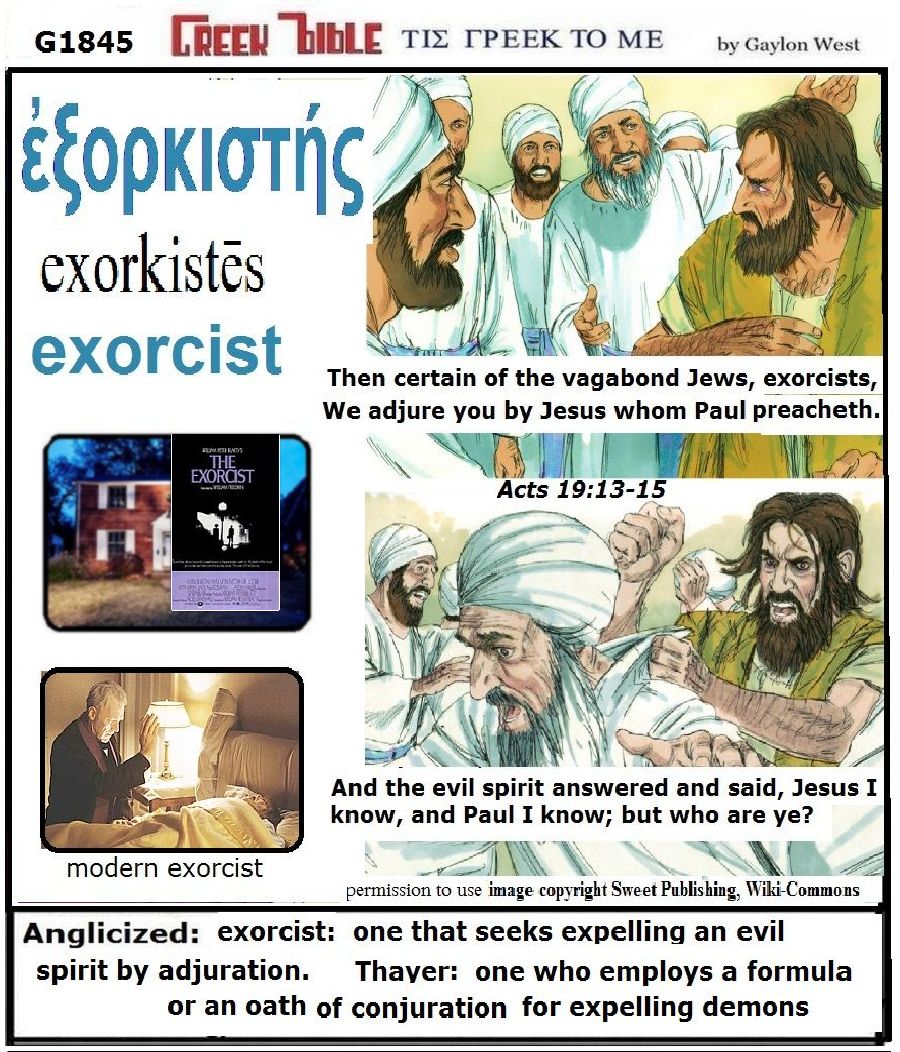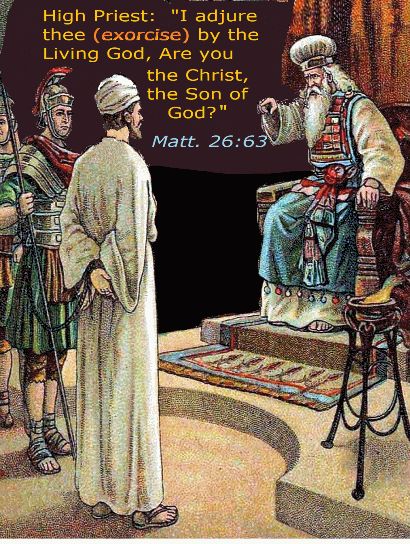
ἐξορκιστής, G1845, exorcist (noun)
Illustrations
of English words
derived from the Greek in the New Testament.
|
ἐξορκίζω,G1844, exorcism, (verb) Latin, “adjure” |
|
|
Adjure
(v. ) late 14th
c., "to
bind by oath; to question under oath;"
entered
English language c. 1400 AD as "to charge with an oath or
under penalty of a curse," from
Latin
adiurare
"confirm
by oath, add an oath, to swear to in addition; call to witness,"
Matthew
26::63, King
James uses this Latin derived English word for the original Greek
word exorcise
which
also carries the “adjure
oath” meaning.
Etymonline.com
ERV has, “You are now under oath. I command you by the power of the living God to tell us the truth.”
Hence, the demon in possession would be “under oath to obey” the exorcist.
Prepared by Gaylon
West.
HISTORIC IRAN AFFECTS FIRST CENTURY JEWS.
The only existing “Jews” in 606 BC were mostly the citizens of Judah (hence, the name “Jews”); the northern brethren had been conquered by Nineveh a hundred years before and scattered throughout the world. Like the “lost tribes” of the north, these remaining disobeying ones in the South were taken captives by the Babylonians under Nebuchadnezzar.
After 70 years (536 BC) the remnant of these Jews were allowed by the “new” conquering Persians under King Cyrus to return to their land and to their Jerusalem. Some returned and are thought to bring with them the superstitious beliefs of Zoroastrianism. “These were certain Jews who went about from place to place, professing by charms and spells to cure diseases."i This religion especially believed in “demon possession.” They brought with them the superstitious incantations of exorcisms and magic sorcery. Hence, we eventually would have the account of the “magician” Simon of Acts 8. This “vagabond Jew” Simon was converted by Philip from this Eastern religion to Christ. Subsequently, Simon being fascinated by the miraculous power of the Holy Spirit that obviously to him effectively exorcise demons rather than what he had been doing. It would have paid him richly. He would not have to “fool” people with his vain rituals. The apostle Peter condemned his sinful action.
The first century Jewish historian Josephus understood “demons” to be “spirits of the wicked which enter into men that are alive and kill them” but could be driven out by a certain “root.” He claimed to have witnessed such a performance in the presence of the Roman Emperor Vespasian. This incantation he professed to believe to have had its origin with King Solomon in mythology. An observation is, “There were few defences against these Babylonian demons.” ii
Jesus was not a Babylonian exorcist. But Jesus demonstrated His authority as the Son of God over all nature including real demons (evil spirits) that actually during the New Testament period apparently “possessed” people. Jesus also gave His first century disciples power over them. The question is, "Which came first, the superstition or the actual possession?" The Scriptures teach the reality of “evil spirits. “You have the belief that God is one, and you do well: the evil spirits have the same belief, shaking with fear. Do you not see, O foolish man, that faith without works is of no use?” (James 2:19,20).
|
|
The term demon (from the Koine Greek δαιμόνιον daimonion) appears 63 times in the New Testament of the Christian Bible, mostly if not all relating to occurrences of possession of individuals and exorcism by Jesus.
There are at least four theories of the identity of demons (unclean spirits) as taught by denominations but each is not consistent with Biblical teaching:
Theory #1: Souls of the wicked deceased, which roam the earth to torment the living. However, no Scripture indicates this. This contradicts Jesus who tells the parable of the rich man and Lazarus in which “And it came to pass, that the beggar died, and that he was carried away by the angels into Abraham's bosom: and the rich man also died, and was buried.And in Hades he lifted up his eyes, being in torments, and seeth Abraham afar off, and Lazarus in his bosom.” (Luke 16:22, 23, ASV). The rich man dies and goes to Hades and not to roam the earth like the cartoon Casper the Ghost.
-
Theory #2: Nephilim, who came into being “by union between angels and human,” but their bodily part were wiped out during the Great flood. Their spiritual part now desires reembodiment. [note: this is interesting since my contact with a proponent of this theory claimed the giants in Canaan were descendents. This contention would make the universal flood a lie.] Contradicts Scriptural principle: Angels do “not marry” (Matthew 22:30). Plus, the Scripture says the “prediluvian” spirits are in “prison” and not wandering: “the Spirit in which also he (Jesus) went and preached unto the spirits in prison [dative case—i.e., now in "lockup"] that aforetime were disobedient, when the longsuffering of God waited in the days of Noah, while the ark was a preparing” (1 Peter 3:19, 20, ASV). "The passage in Genesis, moreover, refers rather to the intermarriage of the descendants of Seth [children of God, an expression used also of Christians] and of cursed Cain"iii and not angels with humans.
-
Theory #3: Personification. "They were simply a primitive means of describing symptoms of what are now known to be mental and emotional disorders, and thus not actual personalities."iv But again, the point is that Jesus interacts with the unclean spirits as real beings.
-
Theory #4: Fallen angels, who sided with Lucifer and were cast out of heaven by Michael after battle. But even these are said to be “locked up.” “ And angels that kept not their own principality, but left their proper habitation, he hath kept in everlasting bonds under darkness unto the judgment of the great day” (Jude 6). Did God allow for a temporary release to demonstrate Jesus' divine power?
BIBLICAL FACTS:
Unclean
spirits (demons) speak
(Luke 4:33-37; 8:30-36); they "recognize
Christ" (Luke 4:41); and they tremble
(James
2:19). These are characteristics of true entities
(beings).
Edersheim points out that exorcism is
absent from the list of "grace" miraculous gifts of 1 Corinthians 12.v But any suggestions from that must not overlook Jesus' promised signs to the apostolic believers in Mark 16:15-20. The power to exorcise demons is actually listed first among the Holy Spirit miraculous signs. Mark 16:17 " And these signs shall follow them that believe; In my name shall they cast out devils; they shall speak with new tongues [Strong's: 'Grk. glossa--implied language']; etc." (Mark 16:17). Exorcism power is a sign promised along with the sign of prophecy. A conclusion can be drawn that when the gift of prophecy stopped, so would have the "sign" gift of exorcism (1 Corinthians 13:8). "Love never faileth: but whether there be prophecies, they shall be done away; whether there be tongues, they shall cease; ... " (ASV)
ONE CAUSE OF PUBLIC SICKNESS: IN ORDER THAT CHRIST MIGHT BE MAGNIFIED. " Jesus answered, Neither did this man sin, nor his parents: but that the works of God should be made manifest in him." (John 9:3).
CHARACTERISTIC OF POSSESSION. The King James Bible translates ἔχωG2192 (echō, not the “sound” ἦχοςG2279 ēchos) as “possessed” in only two exorcism passages Acts 8:7 and Acts 16:16. However, this word is translated “have” or “had” at least 340 plus times and characterizes the type of control the spirit/s had. According to Thayer's the Greek G2192 means “to have (hold) in the hand, in the sense of wearing, to have (hold) possession of the mind (refers to alarm, agitating emotions, etc.), to hold fast keep”, etc. When a demon entered into the body of its victim, control was seized of his faculties thus inflicting him in a variety of ways, both mental and physical. The NT distinguishes between the sources or character of physical maladies. Possession is differentiated from natural causes. For example, "the diseases departed from them, and the evil spirits went out of them” (Acts 19:12). The Bible appears to be silent on the differences. But apparently the witnesses could discern the difference.
The below is from http://www.JewishEncyclopedia.com/articles/5942-exorcism


